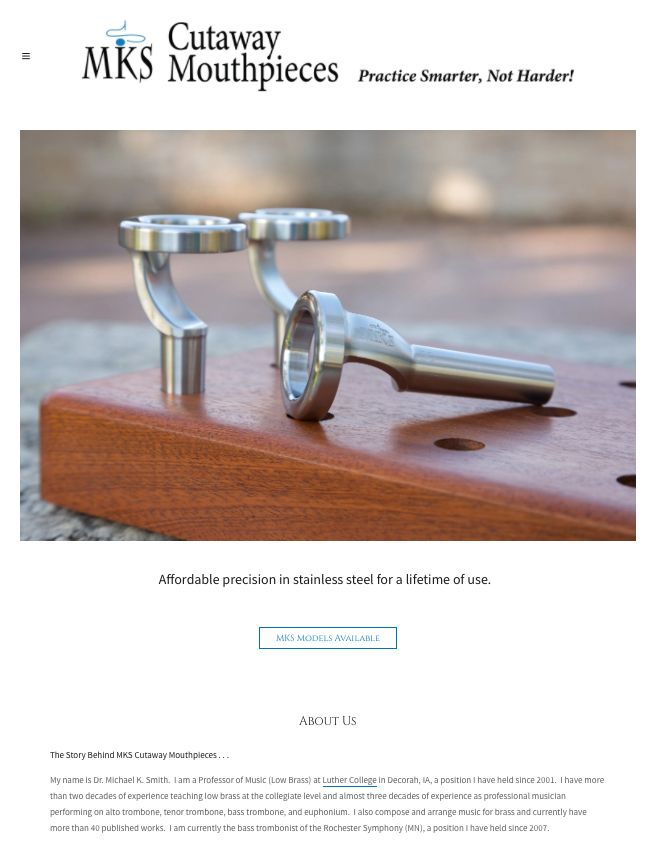MKS Cutaway Mouthpiece Review, Testimony, and Practice Techniques

I recently had the pleasure of receiving a MKS Cutaway Mouthpiece from Dr. Michael Smith, Associate Professor of Trombone at Luther College in Decorah, IA. Dr. Smith’s MKS Cutaway is a result of various DIY versions and developing new uses of the cutaway in daily trombone fundamental practice (I actually bought my first grinder and vice so I could make a cutaway mouthpiece!). Dr. Smith’s experience is that the cutaway is a valuable tool to any trombonist interested in increasing efficiency and decreasing the frustration and pain that can caused by studying the trombone. I agree, much of my playing has been improved by using a cutaway mouthpiece.
Review of the Product: The MKS Cutaway Mouthpiece is packaged in protective packaging. My model, shipped from Iowa via USPS, arrived in great shape to south Louisiana in 3 days. Made of stainless steel, the cutaway is easy to handle and not as heavy as a mouthpiece. You can see more about the product and the specifications for trumpet, horn, bass trombone, euphonium, and tuba versions of the tool on the MKS Cutaway website.

Testimony for use: The MKS Cutaway Mouthpiece can assist students and professionals by improving tone as trombonists develop their buzz on the cutaway. The MKS Cutaway Mouthpiece can also be used as a diagnostic tool, showing the ranges or specific areas the players are having issues with embouchure development, aperture size, jaw placement, and air/wind stream issues. The cutaway system distinctively shows the player all of the issues and allows a fix to be developed quickly. The ways I use the MKS in my own practice and with students include:
- Develop embouchure so the player can use a wind based buzz.
- Create smooth assisted and natural slurs.
- Reduce the pressure on the top lip, so you can play longer and easier.
- Identify issues with embouchure or slide movement manipulation, so the student can focus on practicing.
- Identify extraneous sounds in the tone (you can see what is making them and how to stop it!)
Practice Techniques: These are just the start of technique building ideas, depending on what you need to work on as a player, other practice ideas may be more useful. A good teacher can help direct any student on how to use the cutaway for the best results.
- Play lip slurs on trombone and then buzz them on the MKS Cutaway Mouthpiece.
- Play a melody from the Brad Edwards Lip Slur Melodies book, then buzz and do slide positions with the MKS in the mouthpiece receiver.
- Play a long tone/lip slur exercise on the trombone, then buzz with the MKS in the mouthpiece receiver.
- Play scales/arpeggi with the cutaway.
- Do embouchure movements affect the embouchure?
- Minimize un-needed movements both in the embouchure and the slide.
- Experiment with the aperture size/placement.
- What aperture is best for you in various ranges?
- How does flexibility increase/decrease with different apertures?
- Listen for the teeth disrupting or stopping the air/wind stream.
- You may be able to actually see these disruptions.
- Are they happening in a specific range?
- lowering the jaw or separating the front teeth may help
- Use a breathing tube to aid this change.
- Experiment with air attacks:
- Can you prepare the embouchure for the correct wind to make the sound you want immediately without mouthpiece pressure or using the articulation to aid?
- Use air attack exercises with the MKS Cutaway to aid embouchure development.